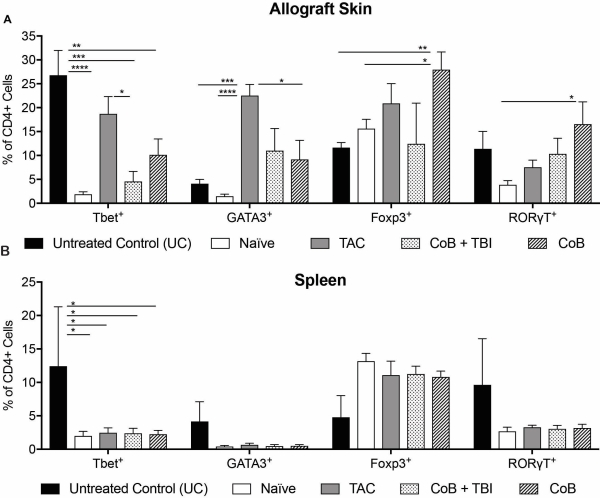Defining T Cell Subsets Involved in Rejection of Vascularized Composite Allografts
1Plastic and Reconstructive Surgery, Johns Hopkins University School of Medicine, Baltimore
2Molecular and Comparative Pathobiology, Johns Hopkins University School of Medicine, Baltimore.
Meeting: 2018 American Transplant Congress
Abstract number: B9
Keywords: Rejection, T helper cells
Session Information
Session Name: Poster Session B: Acute and Chronic Graft Injury
Session Type: Poster Session
Date: Sunday, June 3, 2018
Session Time: 6:00pm-7:00pm
 Presentation Time: 6:00pm-7:00pm
Presentation Time: 6:00pm-7:00pm
Location: Hall 4EF
Background
Vascularized Composite Allotransplantation (VCA) is a clinically feasible therapeutic option for complex tissue defects. The highly immunogenic skin component of VCA represents a therapeutic challenge with more than 85% of allograft recipients experiencing at least one acute cellular rejection (ACR) episode. An improved understanding of acute skin rejection in VCA could elucidate possible mechanisms and reveal novel therapeutic targets.
Methods
We performed orthotopic hind limb transplantats between fully mismatched mouse strain combinations. Wild-type (Wt) Balb/C were donors and C57BL/6 Wt, RORγT-/., IL-4-/-, T-bet-/-and Foxp3DTR were recipients. Mice were assessed daily for rejection. Tissue biopsies, histology, tissue digestion and T cell tissue extraction for flow analysis were performed on POD 8. Treatment groups consisted of C57BL/6 Wt mice receiving 2.0 mg/kg/d Tarolimus, MR1+CTLA4-Ig or MR1+CTLA4-Ig+ total body irradiation (TBI).
Results
All untreated mice underwent ACR. Analysis of CD4+ T cells revealed Tbet+cells as predominant in the skin of RORγT-/- ,IL-4-/- and Foxp3DTR groups. In the spleen, RORγT-/., IL-4-/-and T-bet-/- mice had predominantly Foxp3+ cells. For the untreated Wt control, Tbet+cells predominated in both tissues. Treated animals showed no visual rejection signs at the time of tissue harvest. Tacrolimus resulted in a significantly higher relative Tbet+ and lower Foxp3+ expressions in the skin, compared to the co-stimulation blockade. In the spleen, Foxp3+ cells were predominant in all treatment groups.
Conclusion
Our findings reveal a tissue-specific accumulation pattern of CD4+T cells. The preferential sequestration of Tbet+cells in allograft skin and spleenaffirm the importance of Th1 cells in ACR. Tacrolimus lead to a discrepancy between local and systemic T-cell phenotypes. This differential effect of immunosuppression offers a possible explanation for the high frequency of ACR and should be explored further.
CITATION INFORMATION: Furtmueller G., Malek V., Oh B., Reddy S., Iglesias M., Raimondi G., Brandacher G., Cooney D. Defining T Cell Subsets Involved in Rejection of Vascularized Composite Allografts Am J Transplant. 2017;17 (suppl 3).
To cite this abstract in AMA style:
Furtmueller G, Malek V, Oh B, Reddy S, Iglesias M, Raimondi G, Brandacher G, Cooney D. Defining T Cell Subsets Involved in Rejection of Vascularized Composite Allografts [abstract]. https://atcmeetingabstracts.com/abstract/defining-t-cell-subsets-involved-in-rejection-of-vascularized-composite-allografts/. Accessed December 25, 2025.« Back to 2018 American Transplant Congress
